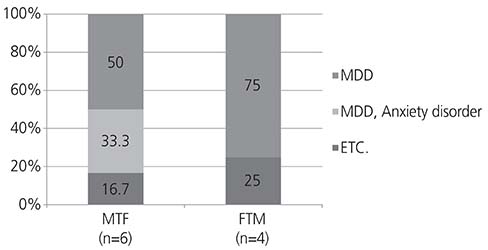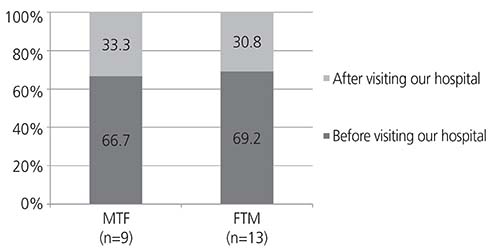Obstet Gynecol Sci.
2019 Jan;62(1):46-55. 10.5468/ogs.2019.62.1.46.
Gender affirmative care of transgender people: a single center's experience in Korea
- Affiliations
-
- 1Department of Obstetrics and Gynecology, Soonchunhyang University Seoul Hospital, Soonchunhyang University, College of Medicine, Seoul, Korea. eslee165@schmc.ac.kr
- KMID: 2430929
- DOI: http://doi.org/10.5468/ogs.2019.62.1.46
Abstract
OBJECTIVE
To investigate the clinical characteristics and medical management of transgender people in South Korea.
METHODS
The electronic medical records of 54 transgender persons who had visited Soonchunhyang University Hospital from January 2016 to December 2017 for medical care were retrospectively reviewed. We identified patient demographics and gender identity-related characteristics. Moreover, we compared our hospital protocol with official guidelines.
RESULTS
At the time of the medical record search, the average age of these 52 transgender persons was 27 years, and 46 (88.5%) were Korean. Ten (19.2%) persons had a mental disorder other than gender dysphoria. Gonadotropin-releasing hormone agonist, estrogen, antiandrogen agents, and testosterone were used according to the guidelines issued by the World Professional Association for Transgender Health and the Endocrine Society. Ten (19.2%) transgender persons, including 6 (22.2%) male-to-females (MTFs) and 4 (16.0%) female-to-males (FTMs), had a mental disorder other than gender dysphoria. Among persons who were administered testosterone, 3 had high triglyceride and lipoprotein cholesterol levels. Nine patients, including 6 (66.7%) MTFs and 3 (33.3%) FTMs, underwent both gonadectomy and gender affirmative surgery. Seven (43.8%) persons, including 1 (14.3%) MTF and 6 (85.7%) FTMs, underwent only gonadectomy. There was a significant difference (P=0.040) between MTFs and FTMs.
CONCLUSION
Medical providers should have adequate knowledge of and experience in managing transgender persons and be familiar with the relevant guidelines and literature. Long-term follow-up examinations should also be performed.
MeSH Terms
-
Cholesterol
Demography
Electronic Health Records
Estrogens
Follow-Up Studies
Gender Dysphoria
Gonadotropin-Releasing Hormone
Humans
Korea*
Lipoproteins
Medical Records
Mental Disorders
Retrospective Studies
Testosterone
Transgender Persons*
Triglycerides
Cholesterol
Estrogens
Gonadotropin-Releasing Hormone
Lipoproteins
Testosterone
Figure
Reference
-
1. Coleman E, Bockting W, Botzer M, Cohen-Kettenis P, DeCuypere G, Feldman J, et al. Standards of care for the health of transsexual, transgender, and gender-nonconforming people, version 7. Int J Transgenderism. 2012; 13:165–232.
Article2. Winter S, Diamond M, Green J, Karasic D, Reed T, Whittle S, et al. Transgender people: health at the margins of society. Lancet. 2016; 388:390–400.
Article3. Reed GM, Drescher J, Krueger RB, Atalla E, Cochran SD, First MB, et al. Disorders related to sexuality and gender identity in the ICD-11: revising the ICD-10 classification based on current scientific evidence, best clinical practices, and human rights considerations. World Psychiatry. 2016; 15:205–221.
Article4. Bakker A, van Kesteren PJ, Gooren LJ, Bezemer PD. The prevalence of transsexualism in The Netherlands. Acta Psychiatr Scand. 1993; 87:237–238.
Article5. Tsoi WF. The prevalence of transsexualism in Singapore. Acta Psychiatr Scand. 1988; 78:501–504.
Article6. Van Caenegem E, Wierckx K, Elaut E, Buysse A, Dewaele A, Van Nieuwerburgh F, et al. Prevalence of gender nonconformity in Flanders, Belgium. Arch Sex Behav. 2015; 44:1281–1287.
Article7. Glen F, Hurrell K. Technical note: measuring gender identity. Manchester: Equality and Human Rights Commission;2012.8. Herman JL, Flores AR, Brown TN, Wilson BD, Conron KJ. Age of individuals who identify as transgender in the United States. Los Angeles (CA): The Williams Institute, UCLA School of Law;2017.9. Kuyper L, Wijsen C. Gender identities and gender dysphoria in the Netherlands. Arch Sex Behav. 2014; 43:377–385.
Article10. Clark TC, Lucassen MF, Bullen P, Denny SJ, Fleming TM, Robinson EM, et al. The health and well-being of transgender high school students: results from the New Zealand adolescent health survey (Youth'12). J Adolesc Health. 2014; 55:93–99.
Article11. Conron KJ, Scott G, Stowell GS, Landers SJ. Transgender health in Massachusetts: results from a household probability sample of adults. Am J Public Health. 2012; 102:118–122.
Article12. Lee H, Park J, Choi B, Yi H, Kim SS. Barriers to transition-related healthcare among Korean transgender adults: focused on gender identity disorder diagnosis, hormone therapy, and sex reassignment surgery. Epidemiol Health. 2018; 40:e2018005.13. Price TM, Blauer KL, Hansen M, Stanczyk F, Lobo R, Bates GW. Single-dose pharmacokinetics of sublingual versus oral administration of micronized 17 β-estradiol. Obstet Gynecol. 1997; 89:340–345.14. Hong J, Lee D, Ham B, Lee S, Sung S, Yoon T, et al. The survey of mental disorders in Korea. Sejong: Ministry of Health & Welfare;2017.15. Haas AP, Rodgers PL, Herman JL. Suicide attempts among transgender and gender non-conforming adults: findings of the national transgender discrimination survey. Los Angeles (CA): The Williams Institute;2014.16. Hyde Z, Doherty M, Tilley M, McCaul K, Rooney R, Jancey J. The first Australian national trans mental health study: summary of results. Perth: School of Public Health, Curtin University;2013.17. Toorians AW, Thomassen MC, Zweegman S, Magdeleyns EJ, Tans G, Gooren LJ, et al. Venous thrombosis and changes of hemostatic variables during cross-sex hormone treatment in transsexual people. J Clin Endocrinol Metab. 2003; 88:5723–5729.
Article18. Lakier JB. Smoking and cardiovascular disease. Am J Med. 1992; 93:8S–12S.
Article19. Hembree WC, Cohen-Kettenis PT, Gooren L, Hannema SE, Meyer WJ, Murad MH, et al. Endocrine treatment of gender-dysphoric/gender-incongruent persons: an endocrine society clinical practice guideline. J Clin Endocrinol Metab. 2017; 102:3869–3903.
Article20. Spinder T, Spijkstra JJ, van den Tweel JG, Burger CW, van Kessel H, Hompes PG, et al. The effects of long term testosterone administration on pulsatile luteinizing hormone secretion and on ovarian histology in eugonadal female to male transsexual subjects. J Clin Endocrinol Metab. 1989; 69:151–157.
Article21. Lips P, Asscheman H, Uitewaal P, Netelenbos JC, Gooren L. The effect of cross-gender hormonal treatment on bone metabolism in male-to-female transsexuals. J Bone Miner Res. 1989; 4:657–662.
Article22. Santucci RA. Urethral complications after transgender phalloplasty and strategies to treat them and minimize their occurrence. Clin Anat. 2018; 31:187–190.



